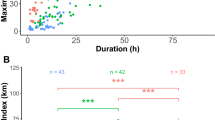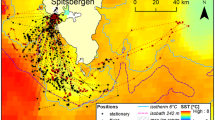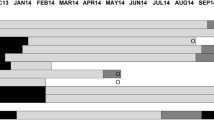Abstract
THE emperor penguin (Aptenodytes forsteri), which feeds only at sea, is restricted to the higher latitudes of the antarctic sea-ice habitat1–3. It breeds on the winter fast ice when temperatures are−30 °C and high winds are frequent3. Assuming entirely the task of incubating the single egg, the male fasts for about 120 days in the most severe conditions. When it is relieved by the female around hatching time, the distance between the colony and the open sea may be 100km or more4,5, but where emperors go to forage at that time or during the summer is unknown. The polynias are areas of open water in sea-ice and during winter, with the under-ice habitats at any time of the year, they are among the most difficult of all Antarctic areas to sample. Here we monitor by satellite the routes taken by emperor penguins for foraging and compare them with satellite images of sea-ice. Winter birds walking over fast ice travelled up to 296 km to feed in polynias, whereas those swimming in light pack-ice travelled as far as 895km from the breeding colony. One record of diving showed that although most dives are to mid-water depths, some are near the bottom. Obtaining such detailed information on foraging in emperor penguins means that this bird now offers a unique opportunity to investigate the Antarctic sea-ice habitat.
This is a preview of subscription content, access via your institution
Access options
Subscribe to this journal
Receive 51 print issues and online access
$199.00 per year
only $3.90 per issue
Buy this article
- Purchase on Springer Link
- Instant access to full article PDF
Prices may be subject to local taxes which are calculated during checkout
Similar content being viewed by others
References
Stonehouse, B. Rep. Falkld Isl. Depend Surv. 6, 1–33 (1953).
Le Maho, Y. Am. Sci. 65, 680–693 (1977).
Prévost, J. Ecologie du Manchot empereur (Expéditions Polaires Françaises, Hermann, Paris, 1961)
Dewasmes, G. et al. J. appl. Physiol. 49, 888–896 (1980).
Budd, G. M. Proc. Zool. Soc., Lond. 139, 365–388 (1962).
Fraser, W. R. et al. Polar Biol. 10, 37–41 (1989).
Kooyman, G. L. & Mullins, J. L. Antarctic Ecosystems, Ecological Change and Conservation (eds Kerry, K. R. & Hempel, G.) 169–176 (Springer, Berlin and Heidelberg, 1990).
Willing, R. L. Nature 182, 194–195 (1958).
Author information
Authors and Affiliations
Rights and permissions
About this article
Cite this article
Ancel, A., Kooyman, G., Ponganis, P. et al. Foraging behaviour of emperor penguins as a resource detector in winter and summer. Nature 360, 336–339 (1992). https://doi.org/10.1038/360336a0
Received:
Accepted:
Issue Date:
DOI: https://doi.org/10.1038/360336a0
This article is cited by
-
Crary bank: a deep foraging habitat for emperor penguins in the western Ross Sea
Polar Biology (2020)
-
Coastal polynyas: Winter oases for subadult southern elephant seals in East Antarctica
Scientific Reports (2018)
-
Why do satellite transmitters on emperor penguins stop transmitting?
Animal Biotelemetry (2015)
-
Non-consumptive factors affecting foraging patterns in Antarctic penguins: a review and synthesis
Polar Biology (2012)
-
Movements and wintering areas of breeding age Thick-billed Murre Uria lomvia from two colonies in Nunavut, Canada
Marine Biology (2011)
Comments
By submitting a comment you agree to abide by our Terms and Community Guidelines. If you find something abusive or that does not comply with our terms or guidelines please flag it as inappropriate.



